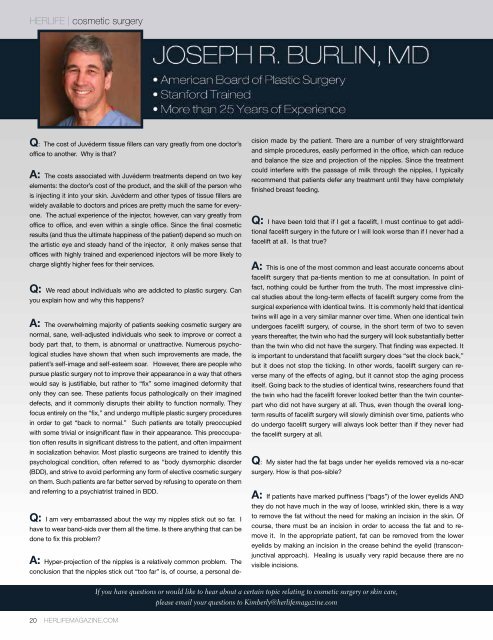GABRIELLA BIEDINGER - HER LIFE Magazine
GABRIELLA BIEDINGER - HER LIFE Magazine
GABRIELLA BIEDINGER - HER LIFE Magazine
You also want an ePaper? Increase the reach of your titles
YUMPU automatically turns print PDFs into web optimized ePapers that Google loves.
herlife | cosmetic surgeryQ: The cost of Juvéderm tissue fillers can vary greatly from one doctor’soffice to another. Why is that?A: The costs associated with Juvéderm treatments depend on two keyelements: the doctor’s cost of the product, and the skill of the person whois injecting it into your skin. Juvéderm and other types of tissue fillers arewidely available to doctors and prices are pretty much the same for everyone.The actual experience of the injector, however, can vary greatly fromoffice to office, and even within a single office. Since the final cosmeticresults (and thus the ultimate happiness of the patient) depend so much onthe artistic eye and steady hand of the injector, it only makes sense thatoffices with highly trained and experienced injectors will be more likely tocharge slightly higher fees for their services.Q: We read about individuals who are addicted to plastic surgery. Canyou explain how and why this happens?A: The overwhelming majority of patients seeking cosmetic surgery arenormal, sane, well-adjusted individuals who seek to improve or correct abody part that, to them, is abnormal or unattractive. Numerous psychologicalstudies have shown that when such improvements are made, thepatient’s self-image and self-esteem soar. However, there are people whopursue plastic surgery not to improve their appearance in a way that otherswould say is justifiable, but rather to “fix” some imagined deformity thatonly they can see. These patients focus pathologically on their imagineddefects, and it commonly disrupts their ability to function normally. Theyfocus entirely on the “fix,” and undergo multiple plastic surgery proceduresin order to get “back to normal.” Such patients are totally preoccupiedwith some trivial or insignificant flaw in their appearance. This preoccupationoften results in significant distress to the patient, and often impairmentin socialization behavior. Most plastic surgeons are trained to identify thispsychological condition, often referred to as “body dysmorphic disorder(BDD), and strive to avoid performing any form of elective cosmetic surgeryon them. Such patients are far better served by refusing to operate on themand referring to a psychiatrist trained in BDD.Q: I am very embarrassed about the way my nipples stick out so far. Ihave to wear band-aids over them all the time. Is there anything that can bedone to fix this problem?A: Hyper-projection of the nipples is a relatively common problem. Theconclusion that the nipples stick out “too far” is, of course, a personal decisionmade by the patient. There are a number of very straightforwardand simple procedures, easily performed in the office, which can reduceand balance the size and projection of the nipples. Since the treatmentcould interfere with the passage of milk through the nipples, I typicallyrecommend that patients defer any treatment until they have completelyfinished breast feeding.Q: I have been told that if I get a facelift, I must continue to get additionalfacelift surgery in the future or I will look worse than if I never had afacelift at all. Is that true?A: This is one of the most common and least accurate concerns aboutfacelift surgery that pa-tients mention to me at consultation. In point offact, nothing could be further from the truth. The most impressive clinicalstudies about the long-term effects of facelift surgery come from thesurgical experience with identical twins. It is commonly held that identicaltwins will age in a very similar manner over time. When one identical twinundergoes facelift surgery, of course, in the short term of two to sevenyears thereafter, the twin who had the surgery will look substantially betterthan the twin who did not have the surgery. That finding was expected. Itis important to understand that facelift surgery does “set the clock back,”but it does not stop the ticking. In other words, facelift surgery can reversemany of the effects of aging, but it cannot stop the aging processitself. Going back to the studies of identical twins, researchers found thatthe twin who had the facelift forever looked better than the twin counterpartwho did not have surgery at all. Thus, even though the overall longtermresults of facelift surgery will slowly diminish over time, patients whodo undergo facelift surgery will always look better than if they never hadthe facelift surgery at all.Q: My sister had the fat bags under her eyelids removed via a no-scarsurgery. How is that pos-sible?A: If patients have marked puffiness (“bags”) of the lower eyelids ANDthey do not have much in the way of loose, wrinkled skin, there is a wayto remove the fat without the need for making an incision in the skin. Ofcourse, there must be an incision in order to access the fat and to removeit. In the appropriate patient, fat can be removed from the lowereyelids by making an incision in the crease behind the eyelid (transconjunctivalapproach). Healing is usually very rapid because there are novisible incisions.If you have questions or would like to hear about a certain topic relating to cosmetic surgery or skin care,please email your questions to Kimberly@herlifemagazine.com20 <strong>HER</strong><strong>LIFE</strong>MAGAZINE.COM
















